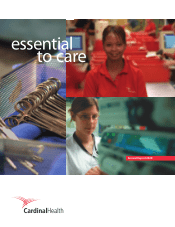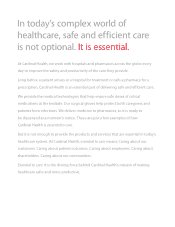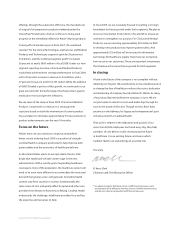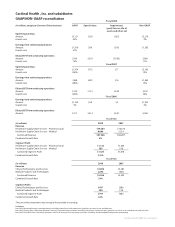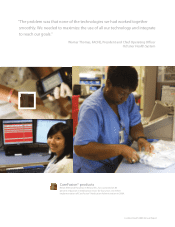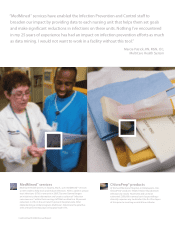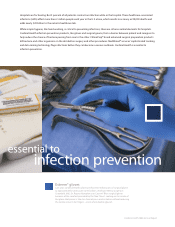Cardinal Health 2008 Annual Report Download
Download and view the complete annual report
Please find the complete 2008 Cardinal Health annual report below. You can navigate through the pages in the report by either clicking on the pages listed below, or by using the keyword search tool below to find specific information within the annual report.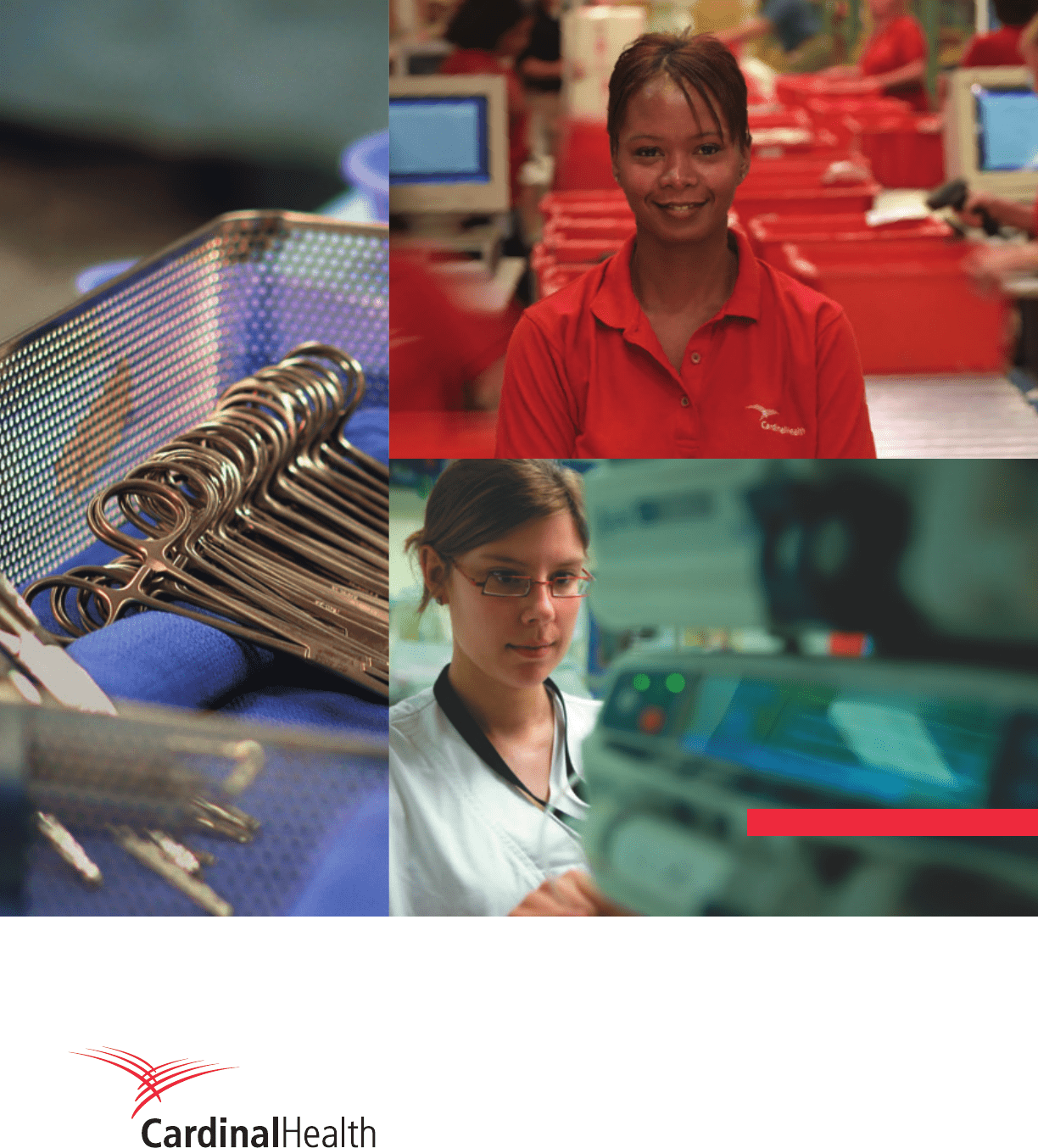
Annual Report 2008
essential
to care
Table of contents
-
Page 1
essential to care Annual Report 2008 -
Page 2
-
Page 3
... Our surgical gloves help protect both caregivers and patients from infections. We deliver medicine to pharmacies, so it is ready to be dispensed at a moment's notice. These are just a few examples of how Cardinal Health is essential to care. But it is not enough to provide the products and services... -
Page 4
... Services and Clinical and Medical Products have very different characteristics and need the flexibility to deploy resources and manage operations that optimize their business models and deliver value to customers. R. Kerry Clark, Chairman and Chief Executive Officer Cardinal Health 2008 Annual... -
Page 5
... of a pharmaceutical and medical product supply chain business provides us the opportunity to serve hospitals, clinical laboratories, ambulatory care centers and doctors' offices with the industry's most e cient network of distribution centers. Our ability to improve the customer experience and to... -
Page 6
...revenue* for the Clinical Technologies and Services and Medical Products and Technologies segments grew by 24 percent to $5.6 billion, and the combined segment profit* increased 36 percent to nearly $800 million in fiscal 2008. Under our new segment reporting structure, Clinical and Medical Products... -
Page 7
...operations excluding special items and impairments, (gain)/loss on sale of assets and other, net, both net of tax. Non-GAAP Diluted EPS from Continuing Operations: non-GAAP earnings from continuing operations divided by diluted weighted average shares outstanding. Cardinal Health 2008 Annual Report -
Page 8
... technology. Alaris® System As part of its commitment to medication safety, Ochsner Medical Center protects patients using the Alaris® System and Guardrails® software with plans to extend their safety platform to patient controlled analgesia monitoring. Cardinal Health 2008 Annual Report -
Page 9
... Chief Operating Officer Ochsner Health System CareFusion® products Beloit Memorial Hospital, in Beloit, Wis., has sustained an 85 percent reduction in medication errors for four years since their implementation of CareFusion® Medication Administration in 2004. Cardinal Health 2008 Annual Report -
Page 10
..., CIC, MultiCare Health System MedMinedâ„¢ services MultiCare Health System, in Tacoma, Wash., uses MedMinedâ„¢ services system-wide to help track and reduce infections. After a spike in urinary tract infections (UTIs) in one unit in 2007, Tacoma General began an initiative to share information and... -
Page 11
... simple hygiene, like hand washing, is critical to preventing infections, there are other essential elements for hospitals. Cardinal Health infection prevention products, like gloves and surgical gowns, form a barrier between patient and caregiver to help reduce the chance of bacteria passing from... -
Page 12
... and Dave's Pharmacy, use sophisticated supply chain technologies such as Cardinal Inventory Manager, cardinal.com ordering, mobile inventory solutions and SOURCE Generics to provide superior service to SM their customers in the competitive retail pharmacy industry. As Cardinal Health helps improve... -
Page 13
...'s Pharmacy in Marysville, Ohio ReadyScan® service Daughters of Charity Health System, in Los Altos Hills, Ca., uses the Cardinal Health ReadyScan® service to provide unit dose barcode packages of pharmaceuticals that they could not get from any other source. Cardinal Health 2008 Annual Report -
Page 14
... Center essential to the OR Pyxis® supply technologies South Georgia Medical Center experienced a $1 million reduction in inventory their first year using Pyxis® supply technologies, and the automation investment produced more than a 200 percent return. Cardinal Health 2008 Annual Report -
Page 15
... to track a hospital's surgical instruments to streamline processing, increase productivity and decrease replacement costs. This real-time tracking helped Dublin Methodist Hospital, in Dubin, Ohio, standardize instrument inventory and manage it more efficiently. Cardinal Health 2008 Annual Report -
Page 16
... safe and secure supply chains Cost savings • Formulary optimization • Improved charge capture • Maximize reimbursements Productivity • Improving and simplifying clinician workflow • Retail pharmacy automation • Just-in-time ordering and distribution Cardinal Health 2008 Annual Report -
Page 17
... site-specific deliveries to retail pharmacies, hospitals, physician offices, surgery centers and alternate care facilities. • One-third of all distributed pharmaceutical, laboratory and medical products flow through the Cardinal Health supply chain. • The largest provider of specialized nuclear... -
Page 18
...company has saved 3 million pounds of packaging material over a five-year period. Hospitals that use single-use surgical draping and gowning systems, like Cardinal Health Convertors® products, can reduce their CO2 emissions by nearly 23 tons and reduce water usage by nearly 700,000 gallons annually... -
Page 19
...corporate social responsibility as continuous improvement in five areas: Customers, shareholders, employees, communities and the environment. Our commitment to these key areas is essential to achieving our vision of becoming the premier, global healthcare company. Cardinal Health 2008 Annual Report -
Page 20
... diluted earnings per share FY06 FY07 FY08 Non-GAAP diluted earnings per share* Segment financials** Healthcare Supply Chain Services 83.9 87.2 1.4 1.5 1.4 3.1 3.5 535 429 Clinical and Medical Products 4.6 735 77.1 FY06 FY07 FY08 Revenue $ billions FY06 FY07 FY08 Segment profit $ billions FY06... -
Page 21
... S. Watkins Chief Human Resources Officer Dwight Winstead Group President Clinical and Medical Products Board of Directors Colleen F. Arnold (H) General Manager, GBS Strategy, Global Consulting Services and SOA Solutions, Global Industries and Global Application Services International Business... -
Page 22
...has been as essential to Cardinal Health than Bob Walter, who as a young man in 1971 bought a small, regional food distribution company and set in motion a growth story few entrepreneurs can match. At the age of 25 and fresh from Harvard Business School, he returned to his hometown of Columbus, Ohio... -
Page 23
... File Number: 1-11373 CARDINAL HEALTH, INC. (Exact name of registrant as specified in its charter) OHIO (State or other jurisdiction of incorporation or organization) 31-0958666 (I.R.S. Employer Identification No.) 7000 CARDINAL PLACE, DUBLIN, OHIO (Address of principal executive offices... -
Page 24
...Disagreements With Accountants on Accounting and Financial Disclosure ...Controls and Procedures ...Other Information ...PART III Directors, Executive Officers and Corporate Governance ...Executive Compensation ...Security Ownership of Certain Beneficial Owners and Management and Related Stockholder... -
Page 25
... statements." This includes, in particular, "Item 7-Management's Discussion and Analysis of Financial Condition and Results of Operations" of this Form 10-K as well as other portions of this Form 10-K. The words "believe," "expect," "anticipate," "project," "will," "could," "would," and similar... -
Page 26
... retail customers (including chain and independent drug stores and pharmacy departments of supermarkets and mass merchandisers), hospitals and alternate care providers (including mail order pharmacies) located throughout the United States. As a full-service wholesale distributor, the pharmaceutical... -
Page 27
... use in nuclear imaging and other procedures in hospitals and clinics. This segment also provides third-party logistics support services, distributes therapeutic plasma to hospitals, clinics and other providers located in the United States and manufactures and markets generic pharmaceutical products... -
Page 28
... Company's pharmaceutical supply chain business generates gross margin primarily to the extent that the selling price to its customers, net of customer discounts, exceeds in the aggregate cost of products sold, net of manufacturer cash discounts, distribution service agreement fees, pharmaceutical... -
Page 29
...-Pharmaceutical segment other than Medicine Shoppe and will comprise all of the businesses formerly within the Healthcare Supply Chain Services-Medical segment. Clinical and Medical Products. This reportable segment will comprise all of the businesses formerly within the Clinical Technologies... -
Page 30
... segment will comprise Medicine Shoppe and the pharmacy services, Tecomet and MedSystems businesses. The Company entered into a definitive agreement to sell the Tecomet business to Charlesbank Capital Partners and Tecomet management on July 22, 2008. As noted above, the Company has publicly... -
Page 31
... of operations and financial condition. Businesses in each of the Company's reportable segments have agreements with group purchasing organizations ("GPOs") that act as agents that negotiate vendor contracts on behalf of their members. Approximately 16% of the Company's revenue for fiscal 2008 was... -
Page 32
...See the "Pharmaceutical Supply Chain Business Model" discussion under "Reportable Segments-Healthcare Supply Chain Services-Pharmaceutical" above for more information regarding distribution service agreement fees. The Company's Healthcare Supply Chain Services-Medical segment purchases products from... -
Page 33
..., benefits offered to both the pharmacist and the customer, access to third-party programs, brand awareness and marketing support and pricing. Medicine Shoppe also needs to be competitive with lower cost retail independent networks or cooperatives that provide support services to pharmacies, as well... -
Page 34
... McKesson Corporation and Omnicell, Inc., as well as emerging companies that supply products for specialized markets and other outside service providers. This segment's pharmacy services compete based on range and quality of services, price, effective use of information systems, development and... -
Page 35
...and sale. These subsidiaries include those that distribute and/or engage in logistics services for prescription pharmaceuticals (including certain controlled substances) and/or medical devices; manage or own pharmacy operations; engage in or operate retail, specialty or nuclear pharmacies; purchase... -
Page 36
... the manufacture and distribution of products also exist in most other countries where the Company's subsidiaries conduct business. In addition, the international manufacturing operations within the Company's Clinical Technologies and Services and Medical Products and Technologies segments are... -
Page 37
... in order to induce the ordering or purchasing of items or services that are in any way paid for by Medicare, Medicaid or other government-sponsored healthcare programs. State attorney general offices have investigated, and may in the future investigate, the Company's operations for compliance with... -
Page 38
... related reporting requirements and other provisions of the DRA will not have an adverse effect on the Company's business. Health Information Practices Services and products provided by certain of the Company's businesses involve access to healthcare information gathered and assessed for the benefit... -
Page 39
... Chain Services-Medical and Clinical Technologies and Services segments to maintain sufficient inventory to meet emergency demands. The Company does not believe that the requirements contained in these U.S. government supply contracts materially impact inventory levels. The Company's customer return... -
Page 40
... wholesale distributors, self-warehousing chains, direct selling manufacturers, specialty distributors, generic pharmaceutical telemarketing distributors and third-party logistics companies, among others. The Company's medical products distribution and manufacturing businesses encounter competition... -
Page 41
... these manufacturers to mitigate the lost gross margin opportunity. See "Item 1-Business-Suppliers" above for more information regarding direct purchase policies. The Company's pharmaceutical supply chain business is subject to appreciation in branded pharmaceutical prices and deflation in generic... -
Page 42
... various state boards of pharmacy, state health departments and/or comparable state agencies as well as foreign agencies and certain accrediting bodies depending upon the type of operations and location of product distribution, manufacturing and sale. There can be no assurance that the Company will... -
Page 43
... separation of its new Healthcare Supply Chain Services and Clinical and Medical Products reportable segments could have an adverse effect on business operations and its assets. On August 7, 2008, the Company publicly announced that its Board of Directors has supported a management recommendation to... -
Page 44
...innovative products in a timely manner would have an adverse effect on its results of operations and financial condition. Even if the Company is able to develop, manufacture and obtain regulatory and reimbursement approvals for its new products, the success of those products would depend upon market... -
Page 45
... oil and natural gas and their derivatives) supplied by others for the manufacturing of its products through its Clinical Technologies and Services and Medical Products and Technologies segments. It is possible that any of the Company's supplier relationships could be interrupted due to natural... -
Page 46
... internal control over financial reporting. The Company relies on information systems in its business to obtain, rapidly process, analyze and manage data to facilitate the purchase and distribution of thousands of inventory items from numerous distribution centers; receive, process and ship orders... -
Page 47
... Supply Chain Services-Medical segment, the Company has 49 medical-surgical distribution and assembly facilities. In its Clinical Technologies and Services segment, the Company has two U.S. assembly and research operation facilities. In its Medical Products and Technologies segment, the Company... -
Page 48
... Officer, Healthcare Supply Chain Services Vice Chairman of Cardinal Health and Chief Executive Officer, Clinical and Medical Products Chief Financial Officer Chief Legal Officer and Secretary Executive Vice President-Strategy and Corporate Development Chief Compliance Officer Chief Human Resources... -
Page 49
... Supply Chain Services since January 2008. Prior to joining the Company, he held several positions with Teva Pharmaceutical Industries Limited, a global pharmaceutical company. He was Executive Vice President-Global Pharmaceutical Markets, President of Teva North America and a member of the Office... -
Page 50
... Supply Chain Services and Clinical and Medical Products reportable segments. The separation being explored could involve a tax-free spin-off of all or a portion of the businesses comprising the Clinical and Medical Products reportable segment as a separate, publicly traded company. Issuer Purchases... -
Page 51
... companies in the health care industry (the "Value Line Health Care Index" or "Peer Group"). The graph assumes, in each case, an initial investment of $100 on June 30, 2003 based on the market prices at the end of each fiscal year through and including June 30, 2008, with the Value Line Health Care... -
Page 52
... periods. The following selected consolidated financial data should be read in conjunction with the Company's consolidated financial statements and related notes and "Item 7-Management's Discussion and Analysis of Financial Condition and Results of Operations." CARDINAL HEALTH, INC. AND SUBSIDIARIES... -
Page 53
... to Report Discontinued Operations." During the third quarter of fiscal 2006, the Company committed to plans to sell a significant portion of its healthcare marketing services business and its United Kingdom-based Intercare pharmaceutical distribution business, thereby meeting the held for sale... -
Page 54
...the new management structure, beginning July 1, 2008, the Company will report results for three reportable segments: Healthcare Supply Chain Services, Clinical and Medical Products and All Other. On August 7, 2008, the Company publicly announced that its Board of Directors has supported a management... -
Page 55
... with a separation. For further information regarding the Company's businesses and the new segment reporting structure, see "Item 1-Business" within this Form 10-K. Financial Overview Continued demand for the Company's products and services during fiscal 2008 led to revenue of $91.1 billion, up... -
Page 56
... per Common Share amounts): Change (1) 2008 2007 Consolidated Results of Operations 2008 2007 2006 Revenue ...Cost of products sold ...Gross margin ...Selling, general and administrative expenses (2) ...Impairments, (gain)/loss on sale of assets and other, net ...Special items ...Operating earnings... -
Page 57
... impacting gross margin included increased sales of clinical and medical products and related services ($204 million), increased manufacturer cash discounts ($193 million), generic pharmaceutical margin ($192 million) and distribution service agreement fees and pharmaceutical price appreciation... -
Page 58
...an investment within the Healthcare Supply Chain Services - Pharmaceutical segment. As a result of the divestiture, the Company recognized a $23 million gain in impairments, (gain)/loss on sale of assets and other, net. See Note 3 of "Notes to Consolidated Financial Statements" for additional detail... -
Page 59
... or 26% during fiscal 2007, which included increased special items charges ($692 million) and impairments, (gain)/loss on sale of assets and other, net ($12 million). Operating earnings were favorably impacted by gross margin growth ($431 million) and negatively impacted by increased SG&A expenses... -
Page 60
... unrecognized tax benefits related to this issue. Subsequent to the fiscal year ended June 30, 2008, the Company received an IRS Revenue Agent's Report for tax years 2003 through 2005, which included the NPAs discussed above and new NPAs related to the Company's transfer pricing arrangements between... -
Page 61
... increase in unrecognized tax benefits for uncertain tax positions related to the PTS Business. Earnings/(Loss) from Discontinued Operations Earnings from discontinued operations, net of tax, decreased by $1.1 billion during fiscal 2008 primarily due to the after-tax gain on the sale of the PTS... -
Page 62
... customers' mail order businesses. Non-bulk customers include retail stores, pharmacies, hospitals, alternate care sites and other customers not specifically classified as bulk customers. Most deliveries to bulk customers consist of product shipped in the same form as received from the manufacturer... -
Page 63
... 2007, the Company revised the method used to allocate certain shared costs between the Healthcare Supply Chain Services-Medical segment and the Medical Products and Technologies segment to better align costs with the segment that receives the related benefits. Prior period information has been... -
Page 64
...and benefit from pharmaceutical price appreciation. Gross margin was also positively impacted during fiscal 2008 by increased manufacturer cash discounts ($72 million) due to increased sales volume. The growth of distribution service agreement fees, pharmaceutical price appreciation and manufacturer... -
Page 65
...'s revenue growth and increased generic pharmaceutical margin ($192 million) due to new product launches and competitive vendor pricing. Gross margin also was favorably impacted by increased manufacturer cash discounts due to sales volume growth ($187 million) and distribution service agreement fees... -
Page 66
... are tracked by manufacturer. Therefore, the Company allocated the distribution service agreement fees and pharmaceutical price appreciation associated with each manufacturer among their products in proportion to sales of each product between bulk and non-bulk customers. Manufacturer cash discounts... -
Page 67
... pricing in a competitive market and the lower costs related to the services provided by the Company. In addition, sales to bulk customers in aggregate generate higher segment cost of products sold as a percentage of revenue than sales to non-bulk customers because bulk customers' orders consist... -
Page 68
...year due to increased customer discounts partially offset by increased manufacturer cash discounts related to sales volume growth. The decrease during fiscal 2008 was also partially offset by an increase in distribution service agreement fees and pharmaceutical price appreciation. During fiscal 2007... -
Page 69
...) and new customer accounts ($100 million). Healthcare Supply Chain Services-Medical segment profit increased $4 million or 1% during fiscal 2007. Gross margin increased segment profit by $27 million primarily as a result of revenue growth and the impact of increased manufacturer cash discounts... -
Page 70
... existing customers and new customers won through new GPO contracts and competitor exits. Revenue growth was also favorably impacted by new product launches ($50 million), including innovations in gloves, respiratory products, surgical instruments and software, and international revenue growth ($62... -
Page 71
... Company will begin reporting in three reportable segments. As of July 1, 2008, the All Other segment includes Medicine Shoppe and the pharmacy services, Tecomet and MedSystems businesses. While these businesses continue to add value to the Company, the Company will be conducting an in-depth review... -
Page 72
...increased accounts receivable ($895 million). The accounts payable, trade receivable and inventory increases were due to new sales volume from an existing large retail chain customer and the timing of inventory purchases from vendors in the Healthcare Supply Chain Services-Pharmaceutical segment. 48 -
Page 73
... cash used to complete acquisitions of Viasys within the Medical Products and Technologies segment, MedMined and Care Fusion within the Clinical Technologies and Services segment and SpecialtyScripts within the Healthcare Supply Chain Services-Pharmaceutical segment. Proceeds from the sale of... -
Page 74
...'s new Healthcare Supply Chain Services and Clinical and Medical Products reportable segments could also impact the amount of share repurchases in fiscal 2009. During fiscal 2008, the Company repurchased approximately $750 million of its Common Shares under a $2.0 billion share repurchase program... -
Page 75
...price per share of $68.39. See "Issuer Purchases of Equity Securities" within "Item 5-Market for Registrant's Common Equity, Related Stockholder Matters and Issuer Purchases of Equity Securities" for further information regarding the Company's most recent share repurchase programs. Capital Resources... -
Page 76
... in the public market. During fiscal 2001, the Company entered into an agreement to periodically sell trade receivables to a special purpose accounts receivable and financing entity (the "Accounts Receivable and Financing Entity"), which is exclusively engaged in purchasing trade receivables from... -
Page 77
...or the minimum amount of goods that must be purchased during the requisite notice period. The significant amount disclosed within fiscal 2008, as compared to other periods, primarily represents obligations to purchase inventories within the Healthcare Supply Chain Services-Pharmaceutical segment. 53 -
Page 78
... sales-type leases to the reserve at June 30, 2008 would result in an increase or decrease in bad debt expense of approximately $6.3 million. Reserve methodologies are assessed annually based on historical losses and economic, business and market trends. In addition, reserves are reviewed quarterly... -
Page 79
...73% at June 30, 2008 and 2007, respectively) are stated at the lower of cost, using the LIFO method, or market. These inventories are included within the core distribution facilities within the Company's Healthcare Supply Chain Services-Pharmaceutical segment ("core distribution facilities") and are... -
Page 80
... the price/earnings ratio for publicly traded companies similar in nature, scope and size. The methods and assumptions used to test impairment have been revised for any segment realignments for the periods presented. The discount rates used for impairment testing are based on the risk-free rate plus... -
Page 81
.... The Company also classifies legal fees and document preservation and production costs incurred in connection with the previouslydisclosed SEC investigation and related Audit Committee internal review and related matters as special items. The majority of the special items related to acquisition... -
Page 82
... tax benefits reflect management's assessment of estimated future taxes to be paid on items in the financial statements. Deferred income taxes arise from temporary differences between financial reporting and tax reporting bases of assets and liabilities, as well as net operating loss and tax credit... -
Page 83
... subsequent to the adoption of SFAS No. 123(R), the Company estimates its future stock price volatility based on implied volatility from traded options on the Company's Common Shares and historical volatility over a period of time commensurate with the contractual term of the option grant (7 years... -
Page 84
... to foreign exchange, interest rate, and commodity related changes. The Company maintains a comprehensive hedging program to manage volatility related to these market exposures. It employs operational, economic, and derivative financial instruments in order to mitigate risk. See Notes 1 and 14 of... -
Page 85
... its normal course of business. These exposures result primarily from operating the Company's distribution, manufacturing, and corporate facilities. In certain deregulated markets, the Company from time to time enters into long-term purchase contracts to supply these items at a specific price. 61 -
Page 86
... Registered Public Accounting Firm ...63 Consolidated Financial Statements and Schedule: Consolidated Statements of Earnings for the Fiscal Years Ended June 30, 2008, 2007 and 2006 ...64 Consolidated Balance Sheets at June 30, 2008 and 2007 ...65 Consolidated Statements of Shareholders' Equity... -
Page 87
... have audited, in accordance with the standards of the Public Company Accounting Oversight Board (United States), the Company's internal control over financial reporting as of June 30, 2008, based on criteria established in Internal Control-Integrated Framework issued by the Committee of Sponsoring... -
Page 88
CARDINAL HEALTH, INC. AND SUBSIDIARIES CONSOLIDATED STATEMENTS OF EARNINGS Fiscal Year Ended June 30, 2008 2007 2006 (In millions, except per common share amounts) Revenue ...Cost of products sold ...Gross margin ...Selling, general and administrative expenses ...Impairments, (gain)/loss on sale of... -
Page 89
CARDINAL HEALTH, INC. AND SUBSIDIARIES CONSOLIDATED BALANCE SHEETS June 30, 2008 June 30, 2007 (In millions) ASSETS Current assets: Cash and equivalents ...Short-term investments available for sale ...Trade receivables, net ...Current portion of net investment in sales-type leases ...Inventories ... -
Page 90
CARDINAL HEALTH, INC. AND SUBSIDIARIES CONSOLIDATED STATEMENTS OF SHAREHOLDERS' EQUITY Common Shares Shares Issued Amount Accumulated Other Total Treasury Shares Retained Comprehensive Shareholders' Earnings Shares Amount Income/(Loss) Other Equity (In millions) BALANCE, JUNE 30, 2005 ...476.5 $ 2,... -
Page 91
... in-process research and development ...18.0 84.5 Equity compensation ...122.3 138.1 Provision for deferred income taxes ...26.9 11.7 Provision for bad debts ...26.1 24.0 Change in operating assets and liabilities, net of effects from acquisitions: ...Increase in trade receivables ...(312.7) (783... -
Page 92
...reportable segments: Healthcare Supply Chain Services-Pharmaceutical; Healthcare Supply Chain Services-Medical; Clinical Technologies and Services; and Medical Products and Technologies. Effective the first quarter of fiscal 2008, the former Medical Products Manufacturing segment was renamed Medical... -
Page 93
... distribution businesses within the Healthcare Supply Chain Services-Pharmaceutical and Healthcare Supply Chain Services-Medical segments and are presented net of an allowance for doubtful accounts. See Note 5 for additional information. Concentrations of Credit Risk and Major Customers. The Company... -
Page 94
... the price/earnings ratio for publicly traded companies similar in nature, scope and size. The methods and assumptions used to test impairment have been revised for any segment realignments for the periods presented. The discount rates used for impairment testing are based on the risk-free rate plus... -
Page 95
... provide services related to such merchandise. Revenue for deliveries that are direct shipped to customer warehouses from the manufacturer whereby the Company acts as an intermediary in the ordering and delivery of products is recorded gross in accordance with FASB Emerging Issues Task Force ("EITF... -
Page 96
... store is opened. Healthcare Supply Chain Services-Medical. This segment recognizes distribution revenue when title transfers to its customers and the business has no further obligation to provide services related to such merchandise. Clinical Technologies and Services. Leasing revenue is accounted... -
Page 97
.... Distribution Service Agreement and Other Vendor Fees. The Company's pharmaceutical supply chain business within the Healthcare Supply Chain Services-Pharmaceutical segment recognizes fees received from its distribution service agreements and other fees received from vendors related to the purchase... -
Page 98
...For those contracts designated as fair value hedges, resulting gains or losses are recognized in net earnings offsetting the exposures of underlying transactions. Carrying values of all contracts are included in other assets or liabilities. The Company's policy requires that contracts used as hedges... -
Page 99
... Statements." These Statements provide guidance on the accounting and reporting for business combinations and minority interests in consolidated financial statements. These Statements are effective for fiscal years beginning after December 15, 2008. The Company is in the process of determining the... -
Page 100
... purchase price allocated to IPR&D in fiscal 2008 represented the Company's preliminary estimate of the fair value of the research and development projects in-process at the time of the acquisition. These projects had not yet reached technological feasibility, were deemed to have no alternative use... -
Page 101
...the purchase price allocated to IPR&D represents the estimated fair value of the research and development projects in-process at the time of the acquisition. These projects had not yet reached technological feasibility, were deemed to have no alternative use and, accordingly, were charged to special... -
Page 102
... legal fees and document preservation and production costs incurred in connection with the previouslydisclosed SEC investigation and related Audit Committee internal review and related matters as special items. For information regarding these investigations, see the Company's Annual Report on Form... -
Page 103
... of internal operations. The third phase of the program, announced in April 2007, focused on moving the headquarters of the Company's Healthcare Supply Chain Services-Medical segment and certain corporate functions from Waukegan, Illinois to the Company's corporate headquarters in Dublin, Ohio... -
Page 104
...of multiple Company-owned pharmacies within Medicine Shoppe and the closure of facilities that were acquired as part of the Syncor International Corporation ("Syncor") acquisition. The costs incurred within the Healthcare Supply Chain Services-Medical segment for fiscal 2008 primarily related to the... -
Page 105
... limited to, the integration of information systems, employee benefits and compensation, accounting, finance, tax, treasury, internal audit, risk management, compliance, administrative services, sales and marketing and other. The costs for fiscal 2008 primarily related to the acquisitions of Viasys... -
Page 106
... competition. The Company has not been a named plaintiff in any of these class actions, but has been a member of the direct purchasers' class (i.e., those purchasers who purchase directly from these drug manufacturers). The total recovery of such claims through June 30, 2008 was $151.8 million (net... -
Page 107
...-Pharmaceutical and Healthcare Supply Chain Services-Medical segments. During fiscal 2006, the Company recorded settlement recoveries of $1.5 million related to certain immaterial litigation matters. Other During fiscal 2008, 2007 and 2006, the Company incurred costs recorded within other special... -
Page 108
...financial performance in order to assess for additional impairment. 5. ACCOUNTS RECEIVABLE Trade receivables are primarily comprised of amounts owed to the Company through its distribution businesses within the Healthcare Supply Chain Services-Pharmaceutical and the Healthcare Supply Chain Services... -
Page 109
...73% at June 30, 2008 and 2007, respectively) are stated at the lower of cost, using the LIFO method, or market. These inventories are included within the core distribution facilities within the Company's Healthcare Supply Chain Services-Pharmaceutical segment ("core distribution facilities") and are... -
Page 110
.... If the Company had used the average cost method of inventory valuation for all inventory within the core distribution facilities, inventories would not have changed in fiscal 2008 or fiscal 2007. In fact, primarily due to continued deflation in generic pharmaceutical inventories, inventories... -
Page 111
... 2008, the Company committed to plans to sell certain smaller, non-core businesses within its Medical Products and Technologies segment, thereby meeting the held for sale criteria set forth in SFAS No. 144. In accordance with SFAS No. 144 and EITF Issue No. 03-13, the net assets of these businesses... -
Page 112
...net assets held for sale to the net expected fair value less costs to sell. At the beginning of fiscal 2008, Humacao was reclassified to continuing operations... millions) Revenue ...Impairments/loss on sale ...Loss before income taxes ...Income tax benefit ...Loss from discontinued operations ... $... -
Page 113
..., Inc. purchase accounting adjustments of $16.7 million. (4) At the end of fiscal 2006, the Company divided the businesses previously reported within the Medical Products and Services segment into the Healthcare Supply Chain Services-Medical and Medical Products and Technologies segments to better... -
Page 114
... within the Medical Products and Technologies segment related to the reclassification of certain smaller, non-core businesses within the segment to held for sale of $37.4 million and the divestiture of a particular line of business of $5.8 million. The allocations of the purchase prices related to... -
Page 115
... notes accrues at a floating rate equal to the three-month LIBOR plus 0.27% payable quarterly. The 2016 Notes mature on October 15, 2016 and interest on the 2016 Notes accrues at 5.80% per year payable semi-annually. The Company also agreed for the benefit of the holders to register the 2009 and... -
Page 116
...interest on the 2012 Notes and 2017 Notes is no longer payable. The Company used the net proceeds from the sale of the 2012 and 2017 Notes to fund a portion of the purchase price of the Viasys acquisition and for other general corporate purposes. In June 2008, the Company sold $300 million aggregate... -
Page 117
... can be extended upon mutual consent of the Company and the lending institutions. This revolving credit facility exists largely to support issuances of commercial paper as well as other short-term borrowings for general corporate purposes and remained unused at June 30, 2008 and 2007, except for $72... -
Page 118
... lapsed. Approximately $1.8 million is included in "State and local income taxes, net of federal benefit" and approximately $28.6 million is included in "Other." As of June 30, 2008 the Company had $3.1 billion of undistributed earnings from non-U.S. subsidiaries that are intended to be permanently... -
Page 119
...related ...Goodwill and other intangibles ...Revenues on lease contracts ...Other ...Total deferred income tax liabilities ...Net deferred income tax liabilities (1) ... $ 40.8 214.2 115.8 209.2 153.6 100...30, 2008, the Company had gross federal, state and international loss and credit carryforwards ... -
Page 120
... tax returns in the U.S. federal jurisdiction, various U.S. state jurisdictions and various foreign jurisdictions. With few exceptions, the Company is subject to audit by taxing authorities for fiscal years ending June 30, 2001 through the current fiscal year. The Internal Revenue Service ("IRS... -
Page 121
... unrecognized tax benefits related to this issue. Subsequent to the fiscal year ended June 30, 2008, the Company received an IRS Revenue Agent Report for tax years 2003 through 2005, which included the NPAs discussed above and new NPAs related to the Company's transfer pricing arrangements between... -
Page 122
... filed in the Cardinal Health federal securities litigation and the Weed complaint discussed below. On September 27, 2006, a derivative complaint was filed by a purported shareholder against certain members of the Human Resources and Compensation Committee of the Company's Board of Directors... -
Page 123
... further provided that the Company and its board of directors adopt a corporate governance enhancement requiring the audit committee of the board to meet in executive session with the Company's Chief Financial Officer and Chief Legal Officer no less than annually. Also under the memorandum... -
Page 124
... a series of press releases and public filings disclosing significant sales growth in Syncor's international business, but omitting mention of certain allegedly improper payments to Syncor's foreign customers, thereby artificially inflating the price of Syncor shares. The consolidated complaint... -
Page 125
... controlled substances to customers of the distribution centers affected by the Orders using other Company distribution centers, in some cases on delayed delivery schedules. In addition, the DEA issued an Order to Show Cause, dated January 30, 2008, pertaining to the license to distribute controlled... -
Page 126
... financial statements. From time to time, the Company receives subpoenas or requests for information from various government agencies, including from state attorneys general, the SEC and the U.S. Department of Justice relating to the business, accounting or disclosure practices of customers... -
Page 127
...as an adjustment to the purchase price of the related entity and would have no impact on the Company's results of operations. In the ordinary course of business, the Healthcare Supply Chain Services-Pharmaceutical segment, from time to time, extends loans to its customers which are subsequently sold... -
Page 128
... and mature through June 2017. The gain/(loss) recorded on the pay-floating interest rate swaps is directly offset by the change in fair value of the underlying debt. Both the derivative instrument and the underlying debt are adjusted to market value at the end of each period with any resulting gain... -
Page 129
... to forward contracts used to manage the Company's foreign exchange exposure of intercompany financing transactions and other balance sheet items subject to revaluation which do not meet the requirements for hedge accounting treatment. The amount of net losses related to these instruments recognized... -
Page 130
... the Company does not have significant exposure to any one counterparty. Management believes the risk of loss is remote and in any event would not be material. Fair Value of Financial Instruments. The carrying amounts of cash and equivalents, trade receivables, accounts payable, notes payable-banks... -
Page 131
... customers. In addition, this segment operates centralized nuclear pharmacies, provides third-party logistics support services, distributes therapeutic plasma to hospitals, clinics and other providers located in the United States and manufactures and markets generic pharmaceutical products for sale... -
Page 132
... customers in the United States and Canada. These solutions include sterile and non-sterile kitting and distribution of medical surgical products into hospitals, surgery centers, laboratories and physician offices. The Clinical Technologies and Services segment develops, manufactures, leases... -
Page 133
... 2007, the Company revised the method used to allocate certain shared costs between the Healthcare Supply Chain Services-Medical segment and the Medical Products and Technologies segment to better align costs with the segment that receives the related benefits. Prior period information has been... -
Page 134
... reported in the consolidated financial statements: (in millions) Depreciation and Amortization Expense 2008 2007 2006 Healthcare Supply Chain Services-Pharmaceutical ...Healthcare Supply Chain Services-Medical ...Clinical Technologies and Services ...Medical Products and Technologies ...Corporate... -
Page 135
...reportable segment will comprise Medicine Shoppe and the pharmacy services, Tecomet and MedSystems businesses. The Company entered into a definitive agreement to sell the Tecomet business to Charlesbank Capital Partners and Tecomet management on July 22, 2008. On August 7, 2008, the Company publicly... -
Page 136
... share units is determined by the number of shares granted and the grant date market price of the Company's Common Shares. The compensation expense recognized for all equity-based awards is net of estimated forfeitures and is recognized using the straight-line method over the awards' service period... -
Page 137
..., net of tax benefits of $12.5 million and $11.9 million, during the fiscal years ended June 30, 2007 and 2006, respectively. (4) Fiscal 2008 equity-based compensation expense includes approximately $8.7 million related to unvested equity awards held by the former Executive Director of the Company... -
Page 138
... from traded options on the Company's Common Shares and historical volatility over a period of time commensurate with the contractual term of the option grant (7 years). The following table provides the range of assumptions used for options valued during fiscal 2008, 2007 and 2006: 2008 2007... -
Page 139
... receivables, plus security interests in the related equipment, to the leasing subsidiary of a bank. In order to qualify for sale treatment under SFAS No. 140, the Company formed wholly-owned, special purpose, bankruptcy-remote subsidiaries (the "SPEs") of its subsidiary, Cardinal Health Solutions... -
Page 140
... minimum annual lease payments under the agreements at June 30, 2008 were approximately $6.5 million. During fiscal 2008, the Company did not repurchase any buildings, equipment, or land under operating lease agreements. During fiscal 2007, the Company repurchased certain buildings, equipment and... -
Page 141
..., except per common share amounts) First Quarter Second Quarter Third Quarter Fourth Quarter (1)(2)(3) Fiscal 2008 Revenue ...Gross margin ...Selling, general and administrative expenses ...Earnings from continuing operations ...Loss from discontinued operations ...Net earnings ...Earnings from... -
Page 142
... August 7, 2008, the Company publicly announced that its Board of Directors has supported a management recommendation to actively explore a potential separation of the Company's new Healthcare Supply Chain Services and Clinical and Medical Products reportable segments, which management is proceeding... -
Page 143
...Over Financial Reporting During the quarter ended September 30, 2007, the Company began processing selected financial transactions for its corporate functions and certain businesses within the Clinical Technologies and Services segment on a newly implemented accounting software system. In April 2008... -
Page 144
... its principal executive officer and the principal financial officer, does not expect that the Company's disclosure controls or its internal control over financial reporting will prevent or detect all error and all fraud. A control system, no matter how well designed and operated, can provide... -
Page 145
... REGISTERED PUBLIC ACCOUNTING FIRM The Shareholders and the Board of Directors of Cardinal Health, Inc. We have audited Cardinal Health, Inc. and subsidiaries' (the "Company") internal control over financial reporting as of June 30, 2008, based on criteria established in Internal Control-Integrated... -
Page 146
...Shareholders (the "2008 Annual Meeting") under the captions "Proposal 1-Election of Directors," "Section 16(a) Beneficial Ownership Reporting Compliance" and "Board of Directors and Committees of the Board" and "Corporate Governance-Policies on Business Ethics; Chief Compliance Officer." Information... -
Page 147
...as Bank One, Columbus, N.A.), as trustee (incorporated by reference to Exhibit 4.3 to the Company's Current Report on Form 8-K filed on October 4, 2006, File No. 1-11373) Registration Rights Agreement, dated October 3, 2006, among Cardinal Health, Inc., Banc of America Securities LLC, Goldman, Sachs... -
Page 148
...5.80% Notes due 2016 6.00% Notes due 2017 5.65% Notes due 2012 Indenture, dated as of June 2, 2008, between Cardinal Health, Inc. and The Bank of New York Trust Company, N.A. (incorporated by reference to Exhibit 4.1 to the Company's Current Report on Form 8-K filed on June 2, 2008, File No. 1-11373... -
Page 149
... made to executive officers in February and August 2008 and thereafter) (incorporated by reference to Exhibit 10.1 to the Company's Quarterly Report on Form 10-Q for the quarter ended December 31, 2007, File No. 1-11373)* Form of Restricted Share Units Agreement under the Cardinal Health, Inc. 2005... -
Page 150
...reference to Exhibit 10.2.4 to the Company's Annual Report on Form 10-K for the fiscal year ended June 30, 2007, File No. 1-11373)* Form of Nonqualified Stock Option Agreement under the Cardinal Health, Inc. Equity Incentive Plan, as amended (grants made to executive officer in March and August 1998... -
Page 151
...amended (grant made to executive officer in August 2004) (incorporated by reference to Exhibit 10.2.14 to the Company's Annual Report on Form 10-K for the fiscal year ended June 30, 2007, File No. 1-11373)* Form of Restricted Share Units Agreement under the Cardinal Health, Inc. Amended and Restated... -
Page 152
... by reference to Exhibit 10.5 to the Company's Quarterly Report on Form 10-Q for the quarter ended December 31, 2007, File No. 1-11373)* Form of Directors' Restricted Share Units Agreement under the Cardinal Health, Inc. 2007 Nonemployee Directors Equity Incentive Plan (incorporated by reference to... -
Page 153
... the Cardinal Health, Inc. Amended and Restated Management Incentive (incorporated by reference to Exhibit 10.7.2 to the Company's Annual Report on Form 10-K for the fiscal year ended June 30, 2007, File No. 1-11373)* Cardinal Health, Inc. Long-Term Incentive Cash Program for Fiscal Years 2006-2008... -
Page 154
... 10.02 to the Company's Current Report on Form 8-K filed on September 25, 2007, File No. 1-11373)* Third Amendment to Second Amended and Restated Employment Agreement, dated August 19, 2008, between Cardinal Health, Inc. and Robert D. Walter* Restricted Share Units Agreement, dated October 15, 2001... -
Page 155
Exhibit Number Exhibit Description 10.17.9 Restricted Share Units Agreement, dated February 1, 2002, between Cardinal Health, Inc. and Robert D. Walter (incorporated by reference to Exhibit 10.50 to the Company's Annual Report on Form 10-K for the fiscal year ended June 30, 2002, File No. 1-11373... -
Page 156
... to the Company's Current Report on Form 8-K filed on March 6, 2007, File No. 1-11373) Commercial Paper Dealer Agreement, dated August 9, 2006, between Cardinal Health, Inc. and Banc of America Securities LLC (incorporated by reference to Exhibit 10.03 to the Company's Annual Report on Form 10-K for... -
Page 157
..., executed by Cardinal Health, Inc. in favor of Cardinal Health Funding, LLC (incorporated by reference to Exhibit 10.25.3 to the Company's Annual Report on Form 10-K for the fiscal year ended June 30, 2007, File No. 1-11373) Computation of Ratio of Earnings to Fixed Charges List of Subsidiaries of... -
Page 158
... 26, 2008. Signature Title /s/ R. KERRY CLARK R. Kerry Clark Chairman and Chief Executive Officer and Director (principal executive officer) Chief Financial Officer (principal financial officer) Vice President and Chief Accounting Officer (principal accounting officer) Director /s/ JEFFREY... -
Page 159
Signature Title /s/ MICHAEL D. O' HALLERAN Michael D. O' Halleran Director /s/ DAVID W. RAISBECK David W. Raisbeck Director /s/ JEAN G. SPAULDING Jean G. Spaulding Director /s/ ROBERT D. WALTER Robert D. Walter Director 135 -
Page 160
CARDINAL HEALTH, INC. AND SUBSIDIARIES SCHEDULE II-VALUATION AND QUALIFYING ACCOUNTS Balance at Beginning of Period Charged to Costs and Expenses Charged to Other Accounts (1)(2) (In millions) Balance at End of Period Description Deductions (3) Fiscal Year 2008: Accounts receivable ...Finance ... -
Page 161
[THIS PAGE INTENTIONALLY LEFT BLANK] -
Page 162
[THIS PAGE INTENTIONALLY LEFT BLANK] -
Page 163
...the Investor Relations department at the corporate office, or by calling Investor Relations at 614.757.5222. Cardinal Health uses its website as a channel of distribution for material company information. Important information, including news releases, analyst presentations and financial information... -
Page 164
Cert no. SCS-COC-00648 Cardinal Health 7000 Cardinal Place Dublin, Ohio 43017

